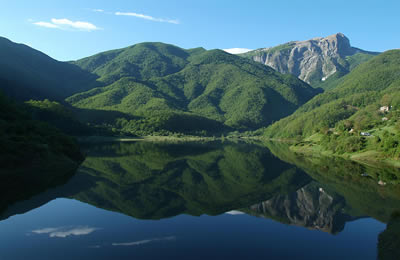A DAY OUT ON 13 JUNE
Let me guide you on a journey to the marble quarries in the Apuan Alps, a range of mountains blessed by a limitless topping of this wonderful stone. I’ve been living in Lucca for more than twenty years, but it was only recently that I went to visit the Fantiscritti quarry which experts regard as one of the best in the world for the pure whiteness of its marble.
One hour by car from Lucca and voilà, you are, to paraphrase the Beatles, “in the sky with marble”.
Take the motorway for Genova, exit at Carrara, go through the village of Moseglia, follow the signs for Fantiscritti and in another twenty minutes you’ll reach your destination.
Once there, the first thing you see is the open-air museum with its display of the old tools and ropes used until a few decades ago. They bear witness to the eternal challenge of mankind against nature and you immediately understand the extent of the exhausting and dangerous work. Many of the marmisti in Carrara can still hear the cries of desperation when a block could not be kept on the tracks and casualties were a frequent occurrence. When we marvel at the marble masterpieces in our museums, we don’t often think of the victims who allowed such sculptures to be made.
Those were the times when marble was wrested almost manually out of the mountains by an army of workers, like ants disputing food. In this hell of human beings and their masterpieces, the mountains were finally taken into consideration and technology was allowed to be the winner.
So now there are two quarries at Fantiscritti eating the mountain – one inside using modern excavation techniques and a traditional one on top in the open air. In the internal one, a block that used to take weeks of work to extract is now quarried in an hour by just a few workers.
A guide takes you inside aboard a small bus and describes the cutting techniques and how blocks are transported. You are struck by how enormous the internal quarry is and by the big marble pillars and arches that have been left in place to stop the mountain caving in. In this way, they have involuntarily built a marble cathedral inside the mountain.
When you leave Fantiscritti, turn left and go to Colonnata, the tiny village where the local delicacy lardo is made with processes in use since the Roman period. It is kept in marble containers and seasoned with herbs and is highly regarded all over Italy. Lardo was important in the diet of the people who transported the marble down the mountain to its destination. By the time you’ve looked around and sampled the specialities of the area, the afternoon is gone.
So, on your way back, you stop in Camaiore, a nice old village five miles inland from Viareggio.
You have dinner in one of the many pleasant restaurants and trattorias while waiting for the evening because on June 13 the traditional sawdust carpet event takes place here once again. During the night, the tappetari, the carpet makers, cover the main streets with colored sawdust carpets on which the Corpus Domini procession will take place the following morning at 10 a.m. Between sunset and dawn, a time of 10 to 12 hours, they make carpets which are two metres wide and 40 metres long.
In fact, the tappetari start working on them a few months earlier because first they have to decide on the subjects (usually religious) to be represented, prepare plywood to transfer the drawings on to the ground, and make templates. I will save most of the detail about how the work is done because it’s more fun when you see for yourself how these masterpieces – which will last only a few hours – are created. It’s a really enjoyable event that only bad weather can spoil.

